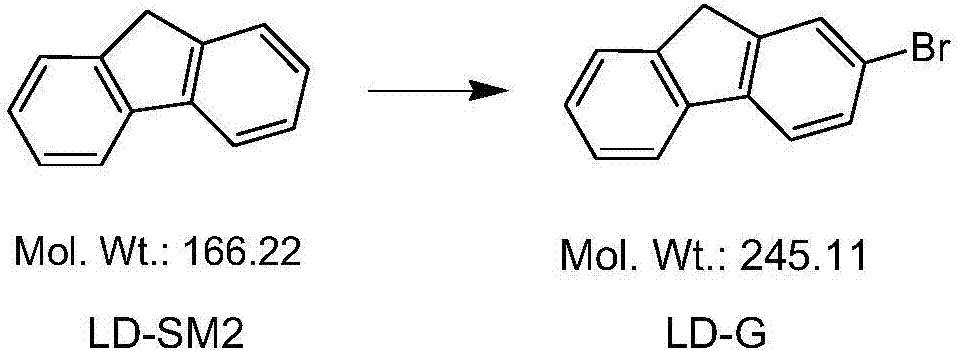Ledipasvir key intermediate and preparation method thereof
An intermediate and key technology, applied in the field of preparation of Ledipavir intermediates, can solve problems such as imperfect process technology, and achieve the effects of safe and reliable production process, mature and stable process, and stable product quality
- Summary
- Abstract
- Description
- Claims
- Application Information
AI Technical Summary
Problems solved by technology
Method used
Image
Examples
Embodiment 1
[0027] A preparation method of the key intermediate LD-J of Radipa Wei, comprising the steps of:
[0028] (1) Preparation of LD-G
[0029] Synthesis process:
[0030]
[0031] Preparation steps: Add LD-SM2 and N-methylpyrrolidone into the reaction kettle, stir until dissolved, add the brominating reagent N-bromosuccinimide in batches, then add the catalyst benzoyl peroxide, and control the reaction temperature Stir the reaction at 60°C for 7 hours, monitor the completion of the reaction by HPLC, cool down to 18°C, add water, separate layers, add methanol to the lower layer liquid, a large amount of solids precipitate out, centrifuge and dry to obtain a white solid LD-G;
[0032] (2) Preparation of LD-H
[0033] Synthesis process:
[0034]
[0035] Preparation steps: Add LD-G and acetic acid into the reaction kettle, heat to 40°C, and stir for 25 minutes to dissolve, adjust the temperature of the reaction kettle to 20°C, add 18% sulfuric acid, then add iodine, potassiu...
Embodiment 2
[0049] A preparation method of Reddy Pavell, comprising the steps of:
[0050] (1) Preparation of LD-G
[0051] Synthesis process:
[0052]
[0053] Preparation steps: Add LD-SM2 and N-methylpyrrolidone into the reaction kettle, stir until dissolved, add the brominating reagent N-bromosuccinimide in batches, then add the catalyst benzoyl peroxide, and control the reaction temperature Stir the reaction at 60-70°C for 7-9 hours, monitor the completion of the reaction by HPLC, cool down to 18-22°C, add water, separate layers, add methanol to the lower layer liquid, a large amount of solids precipitate, centrifuge and dry to obtain a white solid LD-G;
[0054] (2) Preparation of LD-H
[0055] Synthesis process:
[0056]
[0057] Preparation steps: Add LD-G and acetic acid into the reaction kettle, heat to 42°C, and stir for 30 minutes, dissolve, adjust the temperature of the reaction kettle to 25°C, add 20% sulfuric acid, then add iodine, potassium iodate, and The reacti...
Embodiment 3
[0071] (1) Preparation of LD-G
[0072] Synthesis process:
[0073]
[0074] Preparation steps: Add LD-SM2 and N-methylpyrrolidone into the reaction kettle, stir until dissolved, add the brominating reagent N-bromosuccinimide in batches, then add the catalyst benzoyl peroxide, and control the reaction temperature Stir the reaction at 70°C for 9 hours, monitor the completion of the reaction by HPLC, cool down to 22°C, add water, separate layers, add methanol to the lower layer liquid, a large amount of solids precipitate, centrifuge and dry to obtain a white solid LD-G;
[0075] (2) Preparation of LD-H
[0076] Synthesis process:
[0077]
[0078] Preparation steps: Add LD-G and acetic acid into the reactor, heat to 40-45°C, and stir for 25-35 minutes to dissolve, adjust the temperature of the reactor to 20-30°C, add 18-22% sulfuric acid, then Add iodine and potassium iodate, heat the reaction solution at 56-60°C for 3.5-4.5h, monitor the completion of the reaction by ...
PUM
 Login to View More
Login to View More Abstract
Description
Claims
Application Information
 Login to View More
Login to View More - R&D
- Intellectual Property
- Life Sciences
- Materials
- Tech Scout
- Unparalleled Data Quality
- Higher Quality Content
- 60% Fewer Hallucinations
Browse by: Latest US Patents, China's latest patents, Technical Efficacy Thesaurus, Application Domain, Technology Topic, Popular Technical Reports.
© 2025 PatSnap. All rights reserved.Legal|Privacy policy|Modern Slavery Act Transparency Statement|Sitemap|About US| Contact US: help@patsnap.com



